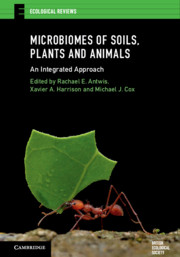Book contents
- Microbiomes of Soils, Plants and Animals
- Ecological Reviews
- Microbiomes of Soils, Plants and Animals
- Copyright page
- Contents
- Contributors
- Preface
- Abbreviations
- Chapter One Microbiomes of soils, plants and animals: an introduction
- Chapter Two Analytical approaches for microbiome research
- Chapter Three Microbiomes of soils
- Chapter Four Factors that shape the host microbiome
- Chapter Five Microbial symbioses and host nutrition
- Chapter Six The microbiome and host behaviour
- Chapter Seven Host microbiomes and disease
- Chapter Eight Adapting to environmental change
- Chapter Nine Microbial biotechnology
- Chapter Ten Synthesis and future directions
- Index
- Plate Section (PDF Only)
- References
Chapter One - Microbiomes of soils, plants and animals: an introduction
Published online by Cambridge University Press: 07 March 2020
- Microbiomes of Soils, Plants and Animals
- Ecological Reviews
- Microbiomes of Soils, Plants and Animals
- Copyright page
- Contents
- Contributors
- Preface
- Abbreviations
- Chapter One Microbiomes of soils, plants and animals: an introduction
- Chapter Two Analytical approaches for microbiome research
- Chapter Three Microbiomes of soils
- Chapter Four Factors that shape the host microbiome
- Chapter Five Microbial symbioses and host nutrition
- Chapter Six The microbiome and host behaviour
- Chapter Seven Host microbiomes and disease
- Chapter Eight Adapting to environmental change
- Chapter Nine Microbial biotechnology
- Chapter Ten Synthesis and future directions
- Index
- Plate Section (PDF Only)
- References
Summary
A classic example of microbiome function is its role in nutrient assimilation in both plants and animals, but other less obvious roles are becoming more apparent, particularly in terms of driving infectious and non-infectious disease outcomes and influencing host behaviour. However, numerous biotic and abiotic factors influence the composition of these communities, and host microbiomes can be susceptible to environmental change. How microbial communities will be altered by, and mitigate, the rapid environmental change we can expect in the next few decades remain to be seen. That said, given the enormous range of functional diversity conferred by microbes, there is currently something of a revolution in microbial bioengineering and biotechnology in order to address real-world problems including human and wildlife disease and crop and biofuel production. All of these concepts are explored in further detail throughout the book.
- Type
- Chapter
- Information
- Microbiomes of Soils, Plants and AnimalsAn Integrated Approach, pp. 1 - 7Publisher: Cambridge University PressPrint publication year: 2020



